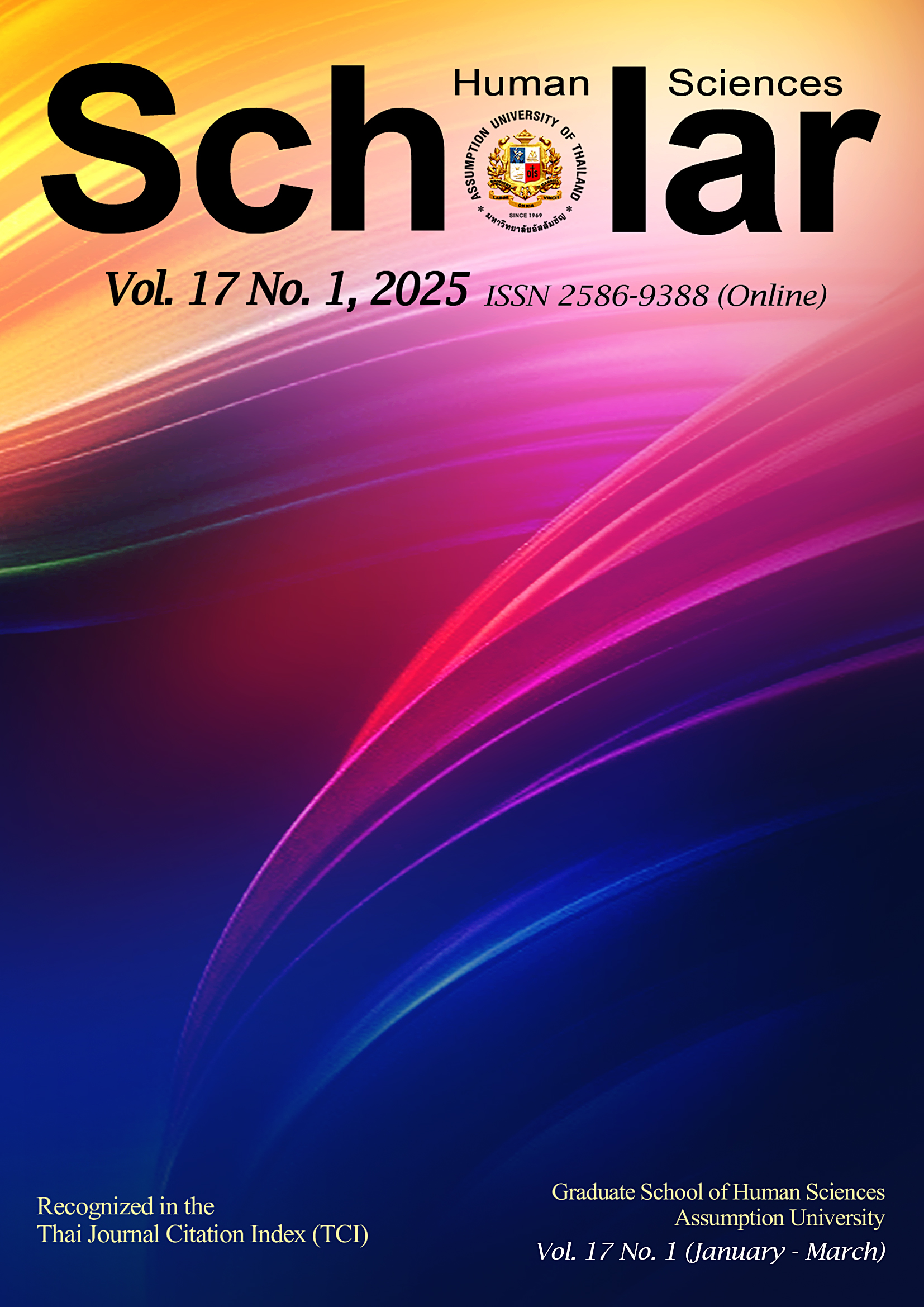Predicting Social Science Undergraduate’s Behavioral Intention to Use Online Library’s Full-Text Resources in Chengdu, China
DOI:
https://doi.org/10.14456/shserj.2025.17Keywords:
Digital Library, Perceived Usefulness, Subjective Norms, Attitude, Behavioral Intention to UseAbstract
Purpose: This study analyzed the factors affecting the behavioral intention to use of full-text digital library resources by social sciences students to provide a new perspective for constructing digital libraries in Chinese colleges and universities. The key variables are system quality, information quality, perceived ease of use, perceived usefulness, subjective norms, attitude, and behavioral intention to use a digital library. Research design, data, and methodology: The study selected 500 undergraduate students with social science disciplinary backgrounds from 10 universities in Chengdu as research subjects. the Index of Item-Objective Congruence (IOC) and Cronbach’s Alpha coefficient were conducted to ensure the validity and reliability before the data collection. Confirmatory factor analysis and structural equation modeling were used to verify the validity of the hypotheses. Results: System quality and information quality significantly influence perceived ease of use and perceived usefulness. Perceived ease of use has a significant influence on perceived usefulness. Perceived usefulness, perceived ease of use and subjective norms significantly influence attitude. Additionally, attitude to use and subjective norms significantly influence behavioral intention to use. Conclusions: The results of this study have positive significance for university libraries, service providers, and users in using digital resources more efficiently, improving college students' information literacy, and even building a learning society.
References
Ajzen, I. (1991). The theory of planned behavior. Organizational Behavior and Human Decision Processes, 50(2), 179-211. https://doi.org/10.1016/0749-5978(91)90020-t
Booker, L. D., Detlor, B., & Serenko, A. (2012). Factors affecting the adoption of online library resources by business students. Journal of the American Society for Information Science and Technology. 63(12), 2503-2520. https://doi.org/10.1002/asi.22723
Chang, C. (2012). Narrative Ads and Narrative Processing. In E. Thorson and S. Rodgers (Eds.), Advertising Theory (pp.241-254). Routledge.
Chang, S.-C., & Lee, M.-S. (2007). A study on relationship among leadership, organizational culture, the operation of learning organization and employees' job satisfaction. The Learning Organization, 14(2), 155-185. https://doi.org/10.1108/09696470710727014
Chau, P. Y. K., & Hu, P. J. H. (2002). Investigating healthcare professionals’ decisions to accept telemedicine technology: an empirical test of competing theories. Information & Management, 39(4), 297-311.
https://doi.org/10.1016/s0378-7206(01)00098-2
Chen, C. C., & Tsai, J. L. (2019). Determinants of behavioral intention to use the Personalized Location-based Mobile Tourism Application: An empirical study integrating TAM with ISSM. Future Generation Computer Systems, 96, 628-638. https://doi.org/10.1016/j.future.2017.02.028
Chintalapati, N., & Daruri, V. S. K. (2017). Examining the use of YouTube as a learning resource in higher education: scale development and validation of tam model. Telematics & Informatics, 34(6), 853-860. https://doi.org/10.1016/j.tele.2016.08.008
Dai, H. M., Teo, T., Rappa, N. A., & Huang, F. (2020). Explaining Chinese university students’ continuance learning intention in the MOOC setting: A modified expectation confirmation model perspective. Computers & Education, 150(5), 38-50. https://doi.org/10.1016/j.compedu.2020.103850
Davis, F. D. (1989). Perceived usefulness, perceived ease of use, and user acceptance of information technology. MIS Quarterly, 13(3), 319-340. https://doi.org/10.2307/249008
Davis, F. D., Bagozzi, R. P., & Warshaw, P. R. (1989). User acceptance of computer technology: a comparison of two theoretical models. Management Science, 35(8), 982-1003. https://doi.org/10.1287/mnsc.35.8.982
DeLone, W., & McLean, E. (1992). Information systems success: the quest for the dependent variable. Information Systems Research, 3(1), 60-95. https://doi.org/10.1287/isre.3.1.60
Diop, E. B., Zhao, S., & Duy, T. V. (2019). An extension of the technology acceptance model for understanding travelers’ adoption of variable message signs. PLoS ONE 14(4), e0216007. https://doi.org/10.1371/journal.pone.0216007
Duan, Y., Liu, B., & He, Y. (2020). Study on relationships among sports spectator motivations, satisfaction, and behavioral intention: empirical evidence from Chinese marathon. International Journal of Sports Marketing and Sponsorship, 21(3), 409-425. https://doi.org/10.1108/ijsms-04-2018-0034
Fauzi, M. A. (2022). Partial least square structural equation modelling (PLS-SEM) in knowledge management studies: Knowledge sharing in virtual communities. Knowledge Management & E-Learning, 14(1), 103124. https://doi.org/10.34105/j.kmel.2022.14.007
Fishbein, M., & Ajzen, I. (2010). Predicting and Changing Behavior: The Reasoned Action Approach (1st ed.). Psychology Press (Taylor & Francis).
George, D., & Mallery, P. (2003). SPSS for Windows Step by Step: A Simple Guide and Reference. 11.0 Update (4th ed.). Allyn & Bacon.
Gorla, N., Somers, T. M., & Wong, B. (2010). Organizational impact of system quality, information quality, and service quality. Journal of Strategic Information Systems, 19(3), 207-228. https://doi.org/10.1016/j.jsis.2010.05.001
Hair, J., Black, W. C., Babin, B. J., Anderson, R. E., & Tatham, R. (2010). Multivariate Data Analysis (1st ed.). Pearson Education.
Hong, J. Y., Suh, E. H., & Kim, S. J. (2009). Context-aware systems: A literature review and classification. Expert Systems with Applications, 36(4), 8509-8522.
https://doi.org/10.1016/j.eswa.2008.10.071
Hu, J., & Zhang, Y. (2016). Chinese students’ behavior intention to use mobile library apps and effects of education level and discipline. Library Hi Tech, 34(4), 639-656.
https://doi.org/10.1108/lht-06-2016-0061
Jeong, H. (2011). An investigation of user perceptions and behavioral intentions towards the e-library. Library Collections, Acquisitions, and Technical Services, 35(2-3), 45-60.
https://doi.org/10.1080/14649055.2011.10766298
Joo, S., & Choi, N. (2016). Understanding users’ continuance intention to use online library resources based on an extended expectation-confirmation model. The Electronic Library, 34(4). 554-571. https://doi.org/10.1108/el-02-2015-0033
Kakhki, M. K., Hadadian, A., Joyame, E. N., & Asl, N. M. (2020). Understanding librarians' knowledge sharing behavior: the role of organizational climate, motivational drives, and leadership empowerment. Library & Information Science Research, 42, 100998. https://doi.org/10.1016/j.lisr.2019.100998
Khan, A., & Qutab, S. (2016). Understanding research students’ behavioural intention in the adoption of digital libraries. Library Review, 65(4/5), 295-319. https://doi.org/10.1108/lr-06-2015-0070
Li, M., & Liu, L. (2023). Students' perceptions of augmented reality integrated into a mobile learning environment. Library Hi Tech, 41(5) 1498-1523. https://doi.org/10.1108/lht-10-2021-0345
Martono, S., Nurkhin, A., Hasan, M., Indah, A., & Wolor, C. (2020). Understanding the Employee's Intention to Use Information System: Technology Acceptance Model and Information System Success Model Approach. Journal of Asian Finance Economics and Business, 7(10), 1007-1013. https://doi.org/10.13106/jafeb.2020.vol7.no10.1007
Maydeu-Olivares, A., & García-Forero, C. (2010). Goodness-of-fit testing (1st ed.). International encyclopedia of education.
Montazemi, A. R., & Qahri-Saremi, H. (2015). Factors affecting adoption of online banking: A meta-analytic structural equation modeling research. Information Management, 52(2), 210-226. https://doi.org/10.1016/j.im.2014.11.002
Mustafa, M. H., Ahmad, M. B., Shaari, Z. H., & Jannat, T. (2021). Integration of tam, tpb, and tsr in understanding library user behavioral utilization intention of physical vs. ebook format. The Journal of Academic Librarianship, 47(5), 102399. https://doi.org/10.1016/j.acalib.2021.102399
Nanayakkara, C., & Whiddett, D. (2005). A model of user acceptance of e-learning technologies: A Case Study of a Polytechnic in New Zealand. Information systems technology and its applications, ISTA’ 2005 4th. International conference, 63, 180-189.
Ngozi, B. U., Onuoha, D., & Nwachukwu, V. N. (2014). Students’ attitudes as a determining factor to electronic information resources use in university, libraries in southwest Nigeria. DESIDOC Journal of Library and Information Technology, 34(4), 333-341. https://doi.org/10.14429/djlit.34.6269
Okeke, I. E., Oghenetga, L. U., & Nwabu, E. C. (2013). Students’ attitude towards the use of reference and information services (RIS) in academic libraries in Nigeria. International Journal of Library and Information Science, 5(10), 335-341.
Okyere-Kwakye, E., & Md Nor, K. (2020). Examining the intentions of a Ghanaian technical university students to use e-library. Digital Library Perspectives, 38(1), 69-87.
https://doi.org/10.1108/dlp-05-2020-0034
Owlia, M. S., Fallah Nezhad, M. S., & Sheikh Sajadieh, M. (2015). A new method for process control based on goodness of fit tests. International Journal of Quality & Reliability Management, 32(2),132-143.
Park, E., & Kim, K. J. (2014). An integrated adoption model of mobile cloud services: exploration of key determinants and extension of technology acceptance model. Telematics and Informatics, 31(3), 376-385. https://doi.org/10.1016/j.tele.2013.11.008
Pramatari, K., & Theotokis, A. (2009). Consumer acceptance of RFID-enabled services: a model of multiple attitudes, perceived system characteristics and individual traits. European Journal of Information Systems, 18(6), 541-552. https://doi.org/10.1057/ejis.2009.40
Rafique, H., Omran, A., Shamim, A., Anwar, F., & Bashir, A. K. (2020). Investigating the Acceptance of Mobile Library Applications with an Extended Technology Acceptance Model (TAM). Computers & Education, 145, 103732. https://doi.org/10.1016/j.compedu.2019.103732
Rogers, E. M. (2003). Diffusion Of Innovations (5th ed.). The Free Press.
Seddon, P. B. (1997). A Respecification and Extension of the DeLone and McLean Model of IS Success. Journal of Information Systems Research, 8, 240-253. http://dx.doi.org/10.1287/isre.8.3.240
Shah, C., & Kitzie, V. (2012). Social Q&A and virtual reference-comparing apples and oranges with the help of experts and users. Journal of the American Society for Information Science and Technology, 63(10), 2020-2036. https://doi.org/10.1002/asi.22699
Silipigni, C. L., & Randall, K. M. (2013). Why the internet is more attractive than the library. The Serials Librarian, 64(1-4), 41-56. https://doi.org/10.1080/0361526x.2013.761053
Soper, D. S. (2020). A-Priori Sample Size Calculator for Structural Equation Models. http://wwwdanielsopercom/statcalc
Srite, M., & Karahanna, E. (2006). The Role of Espoused National Cultural Values in Technology Acceptance. MIS Quarterly, 30, 679-704. https://doi.org/10.2307/25148745
Wu, B., & Chen, X. H. (2017). Continuance intention to use MOOCs: Integrating the technology acceptance model (TAM) and task technology fit (TTF) model. Computers in Human Behavior, 67(C), 221-232. https://doi.org/10.1016/j.chb.2016.10.028
Xu, F., & Du, J. T. (2018). Factors influencing users' satisfaction and loyalty to digital libraries in Chinese universities. Computers in Human Behavior, 83, 64-72.
https://doi.org/10.1016/j.chb.2018.01.029
Yoon, A., & Kim, Y. (2017). Social scientists' data reuse behaviors: Exploring the roles of attitudinal beliefs, attitudes, norms, and data repositories. Library & Information Science Research, 39(3), 224-233. https://doi.org/10.1016/j.lisr.2017.07.008
Yoon, H. (2016). User acceptance of mobile library applications in Academic Libraries: An application of the technology acceptance model. The Journal of Academic Librarianship, 42(6), 687-693. https://doi.org/10.1016/j.acalib.2016.08.003
Zhou, T. (2011). Examining the critical success factors of mobile website adoption. Online Information Review, 35(4), 636-652. https://doi.org/10.1108/14684521111161972
Downloads
Published
How to Cite
Issue
Section
License
Copyright (c) 2025 Wenyuan Zhang

This work is licensed under a Creative Commons Attribution 4.0 International License.
The submitting author warrants that the submission is original and that she/he is the author of the submission together with the named co-authors; to the extend the submission incorporates text passages, figures, data, or other material from the work of others, the submitting author has obtained any necessary permission.
Articles in this journal are published under the Creative Commons Attribution License (CC-BY What does this mean?). This is to get more legal certainty about what readers can do with published articles, and thus a wider dissemination and archiving, which in turn makes publishing with this journal more valuable for you, the authors.




